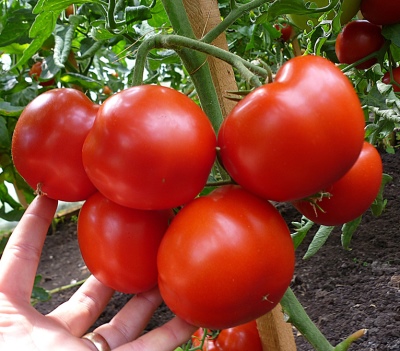
- Authors: MOZSAR JOZSEF
- Year of approval: 2011
- Name synonyms: Gravitet
- Category: hybrid
- Growth type: determinant
- Appointment: fresh consumption, for juice
- Ripening period: early
- Ripening time, days: 95-100
- Growing conditions: for film greenhouses
- Transportability: Yes
Tomato Gravitet can become a faithful companion of a gardener and summer resident in various regions of the Russian Federation. However, in order to achieve full success, its features should be thoroughly studied. An important role is played not only by the declared fertility, but also by the ability to resist negative environmental factors.
Breeding history
The variety was created by breeder Mozsar Joseph (Moscar Jozsef). The culture was allowed to grow in Russian gardens in 2011. The Dutch tomato has already managed to prove itself quite well in domestic conditions.
Description of the variety
The plant has an official synonym - Gravitet. It's a decent determinant hybrid. The crop is declared to be optimal for film greenhouses. The height of the bushes varies greatly - there are specimens of both 0.8 and 1.8 m each. Green leaves of medium size develop on them.
The main qualities of the fruit
When the berry is just forming, and ripening is still ahead, a light green color will be typical. There will be a darker spot near the stem. Ripe tomatoes are always red and do not contain additional colors at all. The mass of ripe fruits is 220-240 g. In shape, they resemble a flat circle.
Ribs in Gravity are present, but relatively weakly expressed. The main stem forms 8-9 racemes. The berries will develop on simple inflorescences. The peduncle has a characteristic articulation.
Taste characteristics
Gravity tomatoes can be used fresh. Tomato juice is also made from them. The pulp of the fruit is juicy. High density is typical for it. The taste is quite pleasant and well balanced, sweet and sour notes are well intertwined.
Ripening and fruiting
Gravity is a good early tomato. It will mature normally in 95-100 days. If you plant seedlings 45 days old, you can harvest in 52-55 days.
Yield
The harvest can reach 11.3 kg of tomatoes per 1 sq. m. Therefore, Gravity is considered a good solution compared to other varieties. According to other sources, it will be possible to remove 10-12 kg of fruits from 1 bush in greenhouse conditions. In terms of 1 m2, this reaches 30-36 kg. On a regular bed, the indicators will be 8-9 and 24-27 kg, respectively.
The timing of planting seedlings and planting in the ground
Usually, the seeds are sown in containers in mid-March. In the northern regions of Russia, it is even worth postponing this procedure for a week and a half. Preparation for planting work (preparation of containers, disinfection of seeds and soil) should begin in a few days. It is necessary to plant seedlings after the appearance of 3 real leaves.

Growing tomato seedlings is an extremely important process, because it largely depends on whether the gardener can harvest at all. All aspects must be taken into account, from seedbed preparation to planting in the ground.
Landing scheme
On average, 1 sq. m there may be 3.4-3.6 bush. It would be more correct to plant a smaller one. Then it will be possible to provide complete care.

Growing and care
The variety is suitable mainly for film greenhouses. It can be cultivated outdoors only in relatively southern regions. Once a week, Gravity should be watered with settled warm water. For 1 bush, 5 liters of water are used. It is recommended to form bushes into 1 stem and get rid of all lateral growth. Peat and dry grass are used for mulching.
Other recommendations:
loosen after watering;
weed as needed;
lay a complex mineral dressing every 14 days.




A plant needs different micronutrients at each stage of growth. All fertilizers can be divided into two groups: mineral and organic. Folk remedies are often used: iodine, yeast, bird droppings, eggshells.
It is important to observe the rate and period of feeding. This also applies to folk remedies and organic fertilizers.
Disease and pest resistance
The official description insists on the high resistance of the variety to:
verticillosis;
tobacco mosaic;
fusarium wilting.
Of insects, the bear and the whitefly are threatening. Black pepper infusion helps to defeat the bear. The Phosbecid reagent protects against whitefly. You only need to use any other drugs if these two do not help. In any case, the dosage of chemical protection cannot be exceeded.


Resistant to adverse weather conditions
Gravity tolerates temperature fluctuations. He can survive even a short-term lack of natural light. However, prolonged exposure to cold air or heat can be detrimental to him.
Growing regions
The official description says that they will be able to grow this variety without problems:
Ural;
Volga;
far eastern;
Karelian and Arkhangelsk;
near Moscow;
Siberian;
Caucasian gardeners.
Review overview
Those who have tried to cultivate Gravity tomato note its real advantages over more traditional varieties. Conventional disease prevention measures are sufficient. Bushes will grow quickly both in seedling containers and in the main crop. The grooming is minimal and not overly complicated. Even in a rainy summer, the taste is almost never lost.

























































































